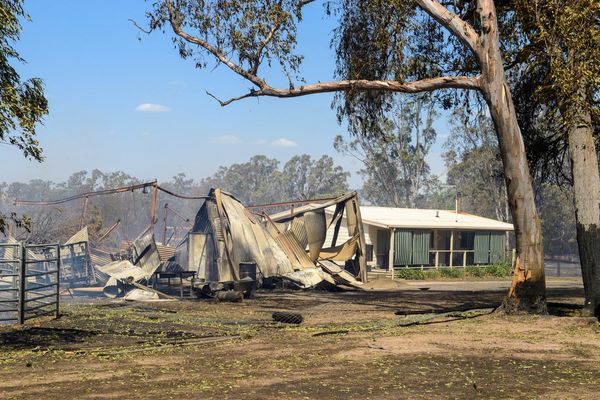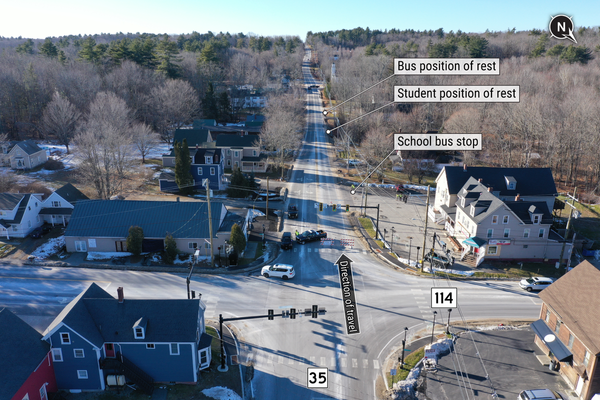Kate Naughton was reading a book at home in Ferny Creek on Mount Dandenong, when her house was sliced in half by a tree.
Photos from the time show the diplomas still hanging on the wall of her study, centimetres from where a 200-tonne eucalypt crashed through the roof.
"It was terrifying," she said.
One year on from the destructive storm that lashed the region, she's got a full payout on her insurance, a folder full of plans and reports by experts in bushfire risk, soil and engineering, and the tree has been removed.
But that's it.
The house still stands, like a loaf of bread with a slice cut through the middle, and her kitchen floor is littered with shattered crockery and, ironically, a broken clock.
"There's all these broken pieces of my life still there and nothing's been changed, nothing has been touched," she said.
Her best guess is that, once she has her final permit, it will take another year to build her house, but she knows it's not a great time to be building a house.
"Material shortages are a real issue, supply lines are not great," she said.
"Pine is running short, plaster is running short so we don't actually know how long it's going to take."
Millions of dollars in damage
Kate's house is one of 76 homes the local council says were deemed uninhabitable after a storm swept through the Dandenong Ranges a year ago.
In total 173 buildings were damaged, including 112 homes.
The dangerous winds also tore down trees and destroyed homes in parts of Central Victoria, and led to flooding in parts of Gippsland.
Data from the Insurance Council of Australia shows the storm led to 33,000 insurance claims, incurring costs of $289 million.
So far, 3,700 claims are still ongoing.
Some locals have told the ABC their rebuilds have been hampered by delays with insurance companies.
Dozens of complaints to financial regulator
The Australian Financial Complaints Authority has received 89 complaints in relation to the storm, and has ordered a total of $274,000 be paid out.
It says the top three issues have been claims being denied because of a policy condition, delays, and disputes over the amount.
The chief executive of the Insurance Council of Australia, Andrew Hall, told ABC Radio Melbourne thousands of claims have been paid out.
"I do believe in the overwhelming majority of insurance cases in this country -- particularly in the last few years with bushfires, floods and the like -- we've largely responded the way we need to respond and look after the community," he said.
He said residents should ensure that the coverage they take out on their homes actually covers the worst of the worst.
Bushfire Recovery Victoria, the state agency which supports communities hit by disasters, said recovery was a complex process that took time.
"We recognise the challenges people are facing as they finance, plan and undertake their rebuilds – particularly if rebuilding in bushfire-prone areas or undertaking works at a time when material and labour are in high demand nationwide," a spokesperson said.
"We have cleaned up over 1,000 properties with hazardous debris free of charge, we're funding councils to have specialist staff to help recovery, and the Government has streamlined planning requirements and the application process to help residents rebuild faster."
No way to call for help
Sassafras resident Jeaniene Spink barely slept the night of the storm, but not only because of its ferociousness.
Her elderly and unwell father was less than 20 metres away, living in a cottage on the property.
But with the power, landline, mobile and internet all offline before 9pm, he might as well have been on the other side of the country.
"There was no way of leaving the house because of the severity of the storm and there was no way of me contacting Dad at all," Ms Spink said.
Waking up to find her home surrounded by fallen trees, Ms Spink managed to climb over the debris to her father's cottage.
He urgently needed to get to hospital.
With the driveway and roads blocked by trees and power lines, they were not only trapped, but had no way of calling for help.
"I had a terminally ill father in the cottage with no heating and no means of gaining medical support for him," she said.
Ms Spink eventually made it out on foot, climbing over fallen trees and powerlines to walk to town, where she eventually found a bar of reception to text a friend and raise the alarm.
Poor communications threaten SES volunteers
The telecommunications outage – which affected 34 communities in the Dandenong Ranges – wasn't just a concern for residents, but also for local CFA and SES volunteers.
Emerald SES unit controller Ben Owen said his crews were at times unable to communicate with each other.
"One of our vehicles was crushed during the storm and the crew couldn't communicate that," he said.
Other crew members who couldn't get home that night due to the conditions were unable to let their loved ones know they were okay.
"We are hearing loved ones are not going to let … their SES member out, particularly on bad nights, because they want to know where they are," Mr Owen said.
In Kalorama, CFA volunteers risked their lives to doorknock on every home in the area.
"We were really concerned how many people might be trapped in their homes … And we just didn't know," local resident and Kalorama fire brigade chief Bill Robinson said.
"We were very lucky, nobody was killed and it was really surprising because 44 houses in Kalorama were destroyed."
He said the biggest concern was that nothing had been done to address the issue since.
"We're going to be in a situation where the residents are going to have to look after themselves again, because nobody seems to be doing anything about it," he said.
Telecommunications issues continue as power outages increase
A year on, connectivity in the Dandenong Ranges remains unstable and local telecommunication towers still rely on backup batteries that only last for three to four hours.
One suggested solution is the installation of auto-start generators at telecommunications towers.
"You need to have generators and a backup system," Mr Robinson said.
Yarra Ranges Council Mayor Jim Child said the local community was willing to maintain any new infrastructure for the telecommunications providers.
"We're more than happy to do that," he said.
The local council has been lobbying the state and federal governments and telecommunication providers for action on the issue.
"I think they have a responsibility back to their community to actually provide a good resilient network in terms of emergency," councillor Child said.
The telecommunications woes continued for long after the storm had passed, with some residents waiting months for the NBN to be reconnected.
"Three months we had nothing, the whole area had nothing," Ms Spink said.
Mt Dandenong Primary School was also cut off for more than six weeks.
"It was really hard to keep kids connected … we were having paper packs made out and delivered when they could," acting principal Jake Laurie said.
A recent council survey suggests both the telecommunications and electricity network have deteriorated following the storms.
The frequency of power outages has increased by 41 per cent, while internet outages have increased by 31 per cent.
The state government said there was work being done to increase the resilience of both the electricity network and telecommunications.
Telecommunications providers contacted by the ABC also stated they were making a range of changes to improve the stability of their networks during future disasters.







